Weekly round-up: 02 - 08 Jan 2013
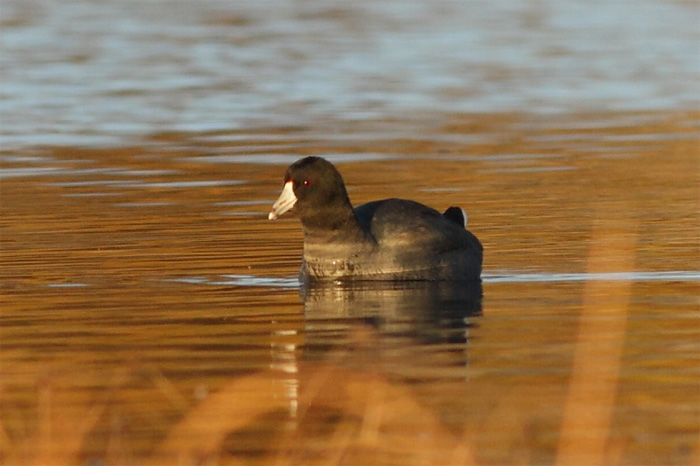
13. Friday the 13th. The baker’s dozen. The number of turns in a hangman’s noose. The title of Teenage Fanclub’s “difficult” second album for Creation Records…. …undoubtedly, the fabled unlucky for some….and a number surrounded by folklore, some bad, some good.
But what of the first few days of the new year ending with a 1 and a 3? What has the early, early days of Twenty Thirteen done for Average Jo Birder? Well, the Christmas leftovers generally remained plentiful as the New Year came along ~ day-listers and year-listers alike seemingly getting a decent bump along on NYD 2013.
That said, it seemed as though the only fireworks let out of the bag were those that shot in to the night sky around midnight on Old Year’s Night ~ a handful of previous New Year holidays have been exciting in extremis….anyone around for the Dorset Little Bustard of January 1988 will certainly testify to that (middle age and beyond does have some advantages….).
The first full week of 2013 was a generally a mild old affair, occasional bouts of tempting sunshine were tempered by grey skies and some rain in parts, and murk and mist in others. The winds were largely from the moist, damp and warm south or southwest ~ little storm activity on hand to shake things up, and no cold snaps to push any roaming flip-flopping Fox Sparrows or Slaty-backed Gulls our way just yet…..
With no sign of the super first-winter male Rose-breasted Grosbeak on St. Mary’s, Isles of Scilly by the close of play on 2nd (it may still be lurking around the islands of course), the honour of the week’s top draw fell to the wintering American Coot, still at Murlach, near Ballyconnelly in County Galway for another week, still present to 8th.
Present since the end of November, there seems to be no real reason why this exciting first-winter visitor won’t hang on for a few more months to come….Ireland’s previous two birds ~ at Ballycotton in 1981 and Termoncarragh in 2010 both departed in early April (on the 4th and 9th respectively) with the latter bird in Mayo being the longest staying American Coot on the books ~ arriving on November 15th it stayed for 146 days until departure by April 10th the following year.
Not far behind in the rarity stakes is the young female Northern Harrier which remained at Tacumshin (Co. Wexford) until 3rd at least. This beautiful bird is coming up for just shy of three months on site (it arrived on October 20th) ~ the wintering first-calendar year female seen at Tacumshin in the winter of 2010-’11 was seen right through in to April of 2011, and again in late May, so there should still be plenty of time available to admire this stunning Transatlantic visitor yet….
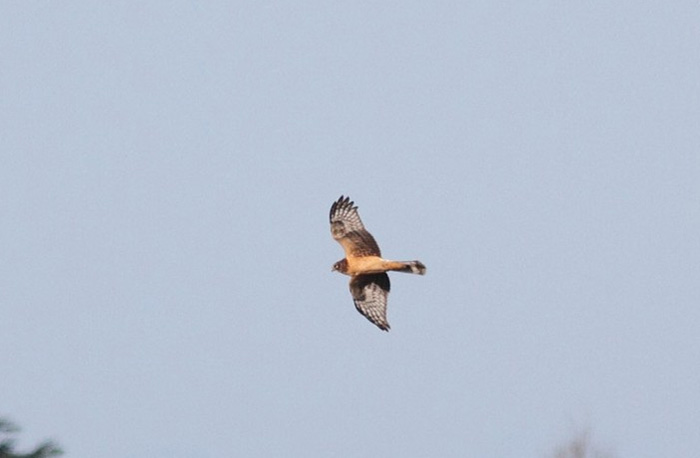
…and as if it needed much more to confirm the Republic’s dominance with regard to the week’s star turns, in Mayo, the drake Black Duck was still on Achill Island’s Sruhill Lough on 5th while the just-before-Christmas reappearance of another drake Black Duck, at Strontian (Highland) became a just-after-New Year-still-present scenario, in place throughout the week……
Down in Cornwall, in the Carrick Roads, the Pacific Diver was reported on 6th but little detail came with the report…
Out at sea, three single Little Auks were reported this week ~ on 3rd at Pennyghael (Argyll) and St. Mary’s (Orkney) with the third noted off Stag Rocks, Bamburgh (Northumberland) on 5th.
The only Balearic Shearwaters of the week were seen in west Cornwall ~ almost all of them reported from Carbis Bay, near St. Ives. Up to five were seen daily throughout the week but a report of at least 50 there on 2nd almost felt like a misprint but that’s what was reported….two were also seen a little further up the Cornish north coast, off Towan Head, Newquay on 5th with four there on 8th.
Two early January Grey Phalaropes were noted too, both on 5th ~ one dropped in at Tacumshin on 5th and another was seen off Garth’s Ness, Mainland (Shetland).
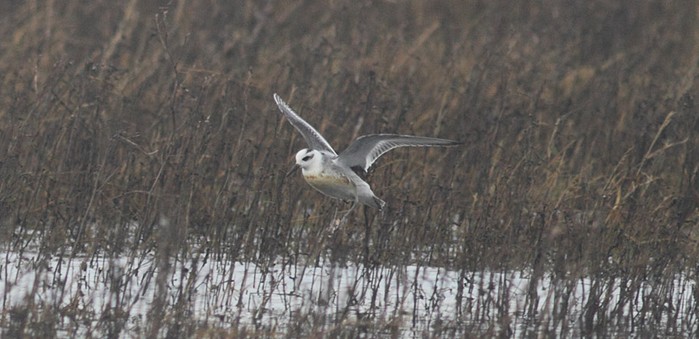
After a rather impressive Christmas sackful of at least 25 birds, numbers of Great White Egrets fell away a touch this week ~ around 20 birds (give or take) noted across England and Wales. Dungeness still reigned supreme, three birds there on 5th, while up to four could have been in and around the Cheshire marshlands this week ~ including two at Frodsham on 5th. Another duo of these most elegant of egrets was at Ham Wall RSPB (Somerset) on 6th.
Elsewhere, a new bird was seen on the rocks at Ferring (West Sussex) on 4th before appearing at Pevensey Levels in next door East Sussex a couple of days later. A second new arrival was seen around the Taw/Torridge Estuary near Bideford between 6th-8th. After that, it was as you were really ~ Welsh interests were represented by singles still in Powys (at Llangorse) and Glamorgan (one again at Llanrhidian), while further English singles were spread across a further eight counties, from Somerset in the southwest to Lancashire in the north, through the Midlands and Home Counties (in Northamptonshire and Buckinghamshire) and on in to East Anglia (a popular bird on Norfolk’s Waveney Marshes) with another again at Horsey on 8th.
In Donegal, at St. Johnston, the Cattle Egret continued to get down’n’dirty with the local pigs until 6th while down in Cork, at Timoleague, one of the week’s three long-staying Glossy Ibis remained for a few more days….still present to 8th.
….meanwhile, in a not particularly hard New Year guessing game, I’ll let you work out where the other two single Ibis were……..
Arguably a more prosaic parlour game would be to come up with suitably enamouring collective noun for Spoonbills ~ it seems a shame to report on just the flock/group/bunch of 17 birds at Arne RSPB on 6th ~ there must be something more becoming than landing them with the siege or sedge that sometimes gets foisted on to herons and cranes….
....away from Dorset, five Spoonbills remained on the north Devon marshes at Yelland throughout the week, three remained on Samson (Scilly) to 5th, two were on the traditional wintering grounds of the River Lynher in south-east Cornwall off and on during the week, with singles in Lancashire (at Banks Marsh) on 4th-5th, West Sussex (flying over Paglesham) on 5th and in Waterford (at Dungarvan) on 6th.
In east Norfolk, 10 Common Cranes were seen from the dunes at Waxham on 5th, after four were seen at nearby Heigham Holmes on 3rd. A single Crane was reported on the north Norfolk coast too this week, seen briefly at Stiffkey on 2nd.
The five Cranes seen for several weeks at Tacumshin remained to 5th at least ~ they seem to be in no hurry to go anywhere fast ~ and the same could be said for the lone bird on Kent’s Walland Marsh, still present to 5th. Another loanee was at Martin Mere WWT on 7th and three birds remained at Lakenheath Fen RSPB (Suffolk) to 8th.
Leading the way for all things wildfowl this week ~ the duo (perhaps trio) of wild and free Red-breasted Geese …..the winter regulars in Dumfries & Galloway, near Loaningfoot and in Hampshire, around Farlington and Portsmouth, were both still present for much of the week (to 6th and 8th).
Quite what anyone can make of the third bird reported as kosher this week, an apparent first-winter at North Warren (Suffolk) is enough to give you a headache…..appearing just after Christmas, the bird (the second newbie on site in a few weeks) is seen loosely in the same vicinity as three adult Red-breasted Geese widely regarded as feral stock.
Where have the new birds come from? Will this one hang on and depart with any passing flocks of Brents it sees heading north along the Suffolk coast or will it ingratiate itself with the three adults and become a long-time resident?
Questions, questions and no little intrigue too. If you’re a year-lister, you may want to hedge your bets and head to the south coast or pass across the border to Scotland…
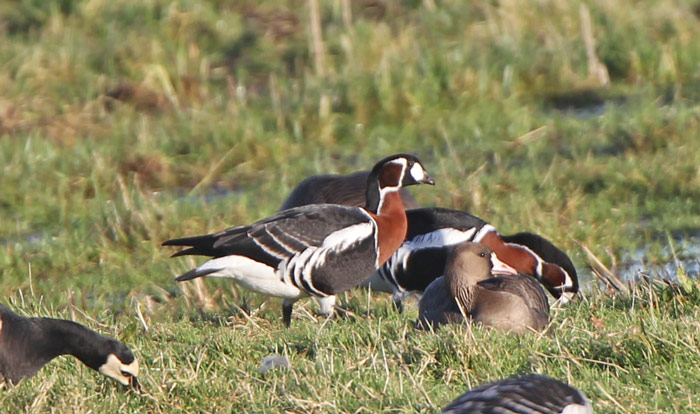
Interestingly, little seems to have been made of the Suffolk Branta’s origins compared with say, ooooh, maybe the much-maligned Canada at Cley ….different species, same scenario potentially. Wild bird in with feral ones and all that jazz.
The Norfolk goose is still taking some heat within the darkest recesses of birding cyber space ~ don’t forget chaps, there’s no law that dictates you must see it! If you don’t want to play the game then, y’know, its ok ….
Oddly enough, after a New Year’s Day which saw rather a lot of optics trained on said Richardson’s Canada Goose (funny that), there have been no more reports this week but that’s presumably because the bird and his feral chums have nipped to Blakeney Freshes or somewhere similar (again).
Certainly there are some (errrrr, me….!) with a little bit of a playful vested interest in seeing BBRC give the thumbs up to this particular visitor to the north Norfolk coast and we’ll round off Soapbox Corner with a (very loosely) borrowed line or two from my posh old chum, the 13th Duke of Wybourne….
“Me, a long time Cley square lister? Here? Banging the gong for a little old goose with no perceived credentials? With my reputation? Am I quite mad? Really…..!”
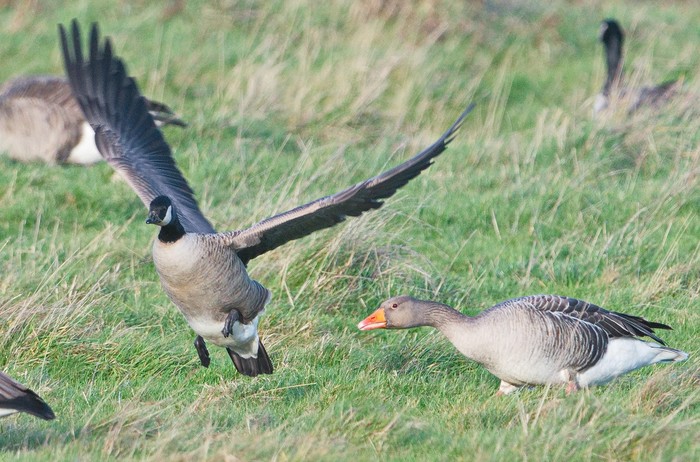
Actually, back in the real world, the only Canadas reported this week were a no-need-for-discussion Richardson’s Canada Goose at Loch Gruinart RSPB, Islay (Argyll) on 8th and a Todd’s Canada Goose (form interior) that was found in the same flock as the D&G Red-breasted Goose at Loaningfoot, present from 2nd – 6th at least while on the Casheen Estuary in County Kerry, a possible Todd’s or Lesser Canada Goose (parvipes) was seen again on 6th.
Up to eight Black Brants (B.(n.) nigricans or B.(n).orientalis) were reported during the week ~ two were seen in north Norfolk, at Stiffkey on 4th and again between Cley and Salthouse on 5th (with a up to three adult hybrids further to the west causing problems again), with singles also at Fishbourne (West Sussex) from 2nd-4th, Shotley Marshes and Chelmondiston (Suffolk) on 3rd and 7th, Old Hall Marshes (Essex) on 5th and Portsmouth on 7th while in Ireland, singles were still at Rosslare Back Strand (Co. Wexford) and Dungarvan (Co. Waterford), also both to 5th.
The only Snow Geese reported this week were the white bird again on Sheskinmore Lough (Co. Donegal) on 6th and a blue bird at Straad, on the Isle of Bute (Argyll) with Greylag Geese, on 7th.
Back in Norfolk (and back in the Cley 10 km square…!), a bird that few would argue was a worthy of picking a fight about ~ the Ross’s Goose (along with his Barnacle buddies) was on the North Scrape, Cley NWT briefly on 8th before heading west.
In County Clare, at least one Lesser Scaup was present on Lough Gash Turlough between 2nd-6th ~ the long-staying first-winter drake joined by a probable female while in Somerset, the drake Lesser Scaup remained at Blagdon Lake until 6th and another drake was still on Bodmin Moor, at Dozmary Pool, on 7th. On Orkney, a young female Lesser Scaup was on Loch of Ayre, St. Mary’s on 6th.
The start of the week saw seven Ring-necked Ducks seen on 2nd ~ three of those remained in Cornwall (two, a drake and a duck at Loe Pool, near Helston and a drake still on the boating lake at Par) with further recent drakes still at Hawkridge Reservoir (Somerset), Marloes Mere (Pembrokeshire) and Lough Doo, on Achill Island (Co. Mayo).
As the week progressed, a further seven had been seen by the end of 7th, taking the total to 13…..a drake was at West Ashby (Lincolnshire) on 3rd and the female was again at Siblyback Reservoir (Cornwall) on 4th when what could have been another drake was seen at Helston, on the boating lake (the two birds on nearby Loe Pool were still together on the same date). Also on 4th, a female Ring-necked Duck was noted at Lough Baun in County Mayo, with further Irish birds following at Lough Shivnagh (Co. Donegal) and Lough Money (Co. Down), both on 6th and both drakes.
Some thirteen drake Green-winged Teals were reported through the last week ~ six in England, two in Scotland and four in Ireland.
English birds included singles lingering at Torpoint (Cornwall) and Hodbarrow RSPB (Cumbria) while new arrivals were at Polemere (Shropshire), Saltholme Pools (Cleveland) Martin Mere WWT (Lancashire), Minsmere RSPB (Suffolk) and Eyebrook Reservoir (Leicestershire) ~ one was found at this last site almost a year ago to the day….
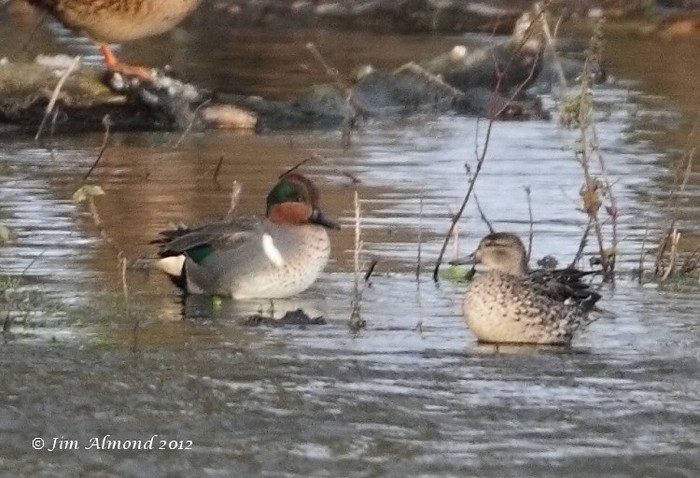
In Scotland, on Orkney, singles were noted on Mainland on 3rd and 4th, at St. Mary’s and Graemeshall respectively, while Ireland’s quartet were still at Murlach (Co. Galway), Timoleague (Co. Cork), Shannon Airport Lagoons (Co. Clare) and Tacumshin (Co. Wexford).
Ireland was also host to the week’s only Blue-winged Teal, the elderly female still on North Bull Island (Co. Dublin) on 7th.
Back to Scotland now and to two of the week’s three American Wigeons, all of them drakes, at least one of which has been seen in previous weeks. That one was the one still at Udale Bay RSPB (Highland) on 2nd, while the other Scottish bird was found at Doocot, near Rosehearty (Aberdeenshire) on 3rd and which was still present on 4th. In Ireland, the oft rarity-free County Leitrim scored a drake American Wigeon at Tullaghan on 7th-8th.
In Rosehearty itself, the drake King Eider showed well from time to time on 4th-5th before heading a few miles along the coast to St. Combs on 6th. On Shetland, the drake King Eider continued to show around the salmon cages at Symbister, on Whalsay, until 7th.
A drake Surf Scoter was again off Ruddon’s Point, Largo Bay (Fife) on 2nd while a female was still off the coast of west Wales, at Broad Haven (Pembrokeshire) throughout the week. Two birds were in Ireland during the week as well ~ still at Dungarvan (Co. Waterford) and near Ballinskelligs (Co. Kerry) on 6th.
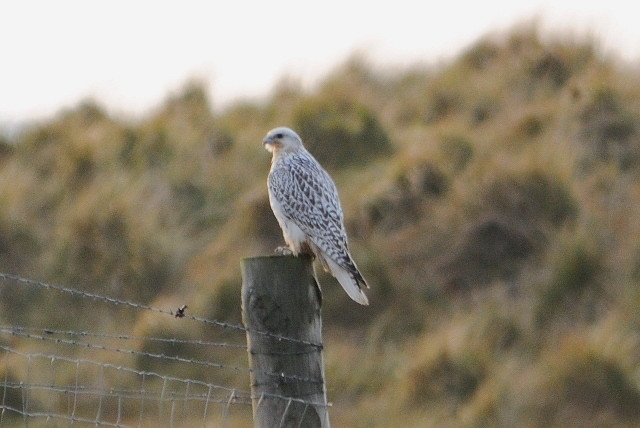
The Outer Hebrides seems to be hosting an elusive though ultra elegant white Gyrfalcon this winter ~ first seen on December 1st, on North Uist, there have been a further seven or eight sightings and it does seem likely that they all refer to one bird.
This week’s sightings were both on 3rd and both on South Uist ~ heading north over Ardvichar Point before alighting half a mile away at North Bay.
In what really has been a lean winter for Rough-legged Buzzards, just four birds were reported this week ~ one remained in the far east of Norfolk, around Haddiscoe and the Waveney Forest throughout the week, with another at Holkham on 8th. Across the Wash, at Gibraltar Point a juvenile showed between 3rd-8th and the fourth bird this week was in Kent, at Capel Fleet, on 6th.
Cambridgeshire’s presumed Dark-breasted Barn Owl remained at the Ouse Fen RSPB reserve until 2nd.
Wintering shorebirds from across the Atlantic included last week’s newly arrived Long-billed Dowitcher on the Gann Estuary (Pembrokeshire), still present on 6th and the first-winter remaining on Lincolnshire’s Alkborough Flats to 8th while in Devon, at Ernesettle, the Lesser Yellowlegs was on station throughout the week as well.
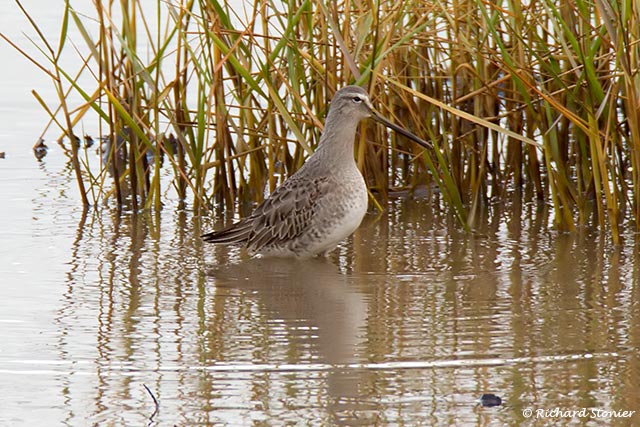
Along the A38 and away up the M5 in Somerset, at Steart, the wintering first-winter Temminck’s Stint was still present to 7th.
It was a triple-shot of Bonaparte’s Gulls this week with at least a couple of regulars both making reappearances. In Devon, the close-to-adult bird was seen again off Langstone Rock at Dawlish Warren on 5th (having last been seen on December 15th) while in Antrim, at Larne, the sporadic adult was back on 6th and 8th (that one was last seen on December 31st).
Our grey-naped, white under-winged trio was completed by an adult on the Ogmore Estuary in Glamorgan from 5th-8th. As with so many species in the round-ups, there is more than chance that this too could also be returning bird ~ one was seen at the same site in January 2008 and in Cardiff Bay every year since. It is possible that it could even be the bird first seen in the area in April 2004…..
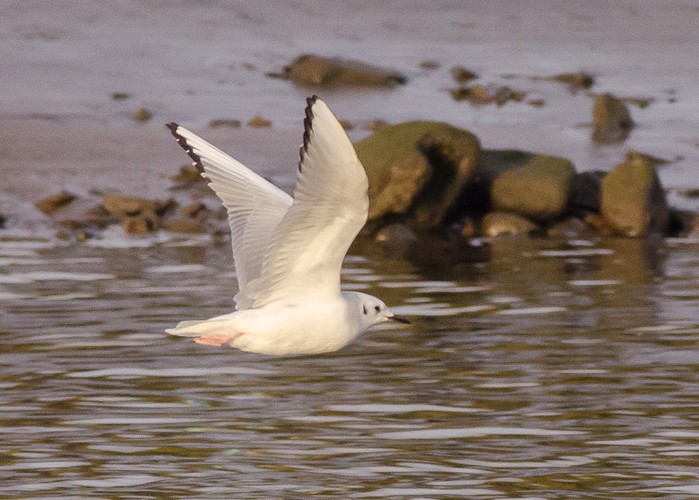
The 13 (there it is again…) Ring-billed Gulls were almost entirely to be found in Ireland ~ up to three were in Kerry (including two, an adult and a first-winter, at Tralee Bay Wetlands for the week with another adult at nearby Blennerville on 6th), while there were still two birds (again another adult and first-winter combo) at O’Callaghan’s Strand (Co. Limerick) to 4th at least. There were two single adults each in Wexford and Dublin, two more for Cork (a second-winter at Timoleague and a new first-winter at Ballydehob) and one for Down (the inevitable third-winter still in situ all week).
In Britain, aside from a first-winter reported at Radipole Lake (Dorset) on 2nd, the only other bird was the regular adult in Hampshire, at Gosport.
A second-winter Kumlien’s Gull was found at Lea Marsh (Lincolnshire) on 2nd (in the company of an occasional Glaucous Gull and a couple of Caspian Gulls too) and was still present to 6th at least. In Cambridgeshire, a possible adult Kumlien’s was reported at the Ouse Washes roost at Witcham on 3rd and it would be tempting to suggest that it may well have been the bird that appeared at the not-too-far-away Grafham Water roost on 6th.
Glaucous Gulls number remained reasonably good from the festive fortnight ~ just under 50 (around 47 or so) recorded during the past week with up to 26 noted in 17 English counties, including three at Broomhead Reservoir and three at Shirecliffe tip (both South Yorkshire) on 5th and 7th respectively. Up to four birds were seen in Cambridgeshire (two at Milton tip and also at the Witcham roost), two were seen in Cheshire and a couple more were noted in Nottinghamshire.
Two singles were seen in Glamorgan (the Principality’s only offering this week), while Scotland saw 10 noted in six counties. Across in Ireland, it was nine birds in six counties, with four at Killybegs (Co. Donegal) on 5th the highest single count at one locality this week.
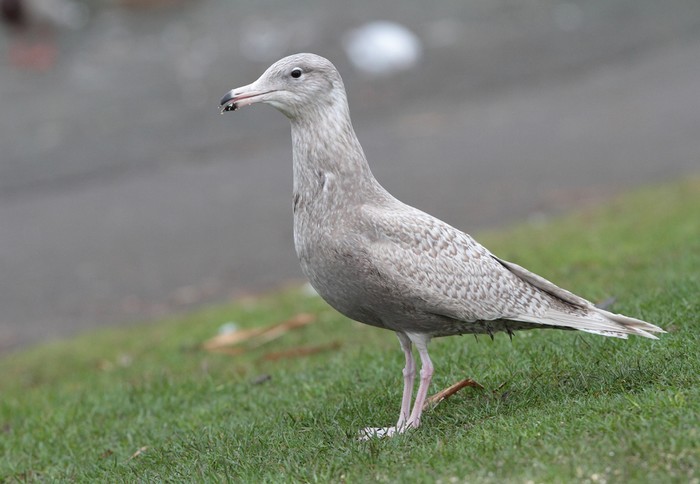
Slightly fewer Iceland Gulls were noted, just under 40 of them this week ~ 15 in 12 English counties, including two at Richmond Bank (Cheshire) on 3rd and two different birds on Scilly towards the end of the week, while 14 birds were spread across eight Scottish counties, including three in Highland and two in the Strathclyde Loch roost on 3rd and two singles on North Uist (Outer Hebrides) at the start of the week. In Ireland, glaucoides outscored hyperboreus by one, 10 birds in six counties including two each for Duncannon in Wexford and Killybegs in Donegal.
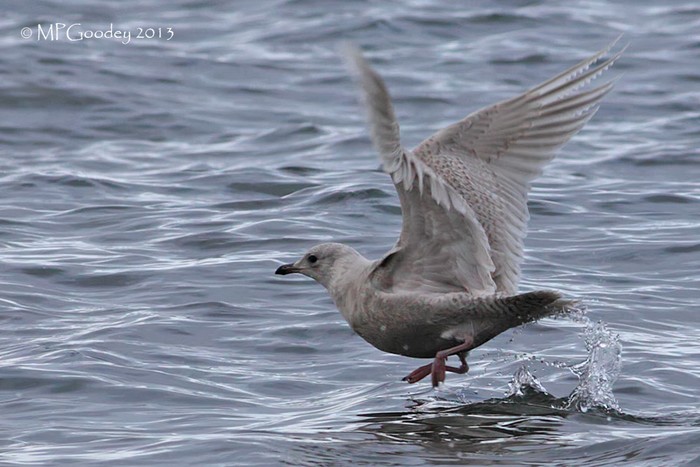
Further down the west coast, in Galway, the usual Forster’s Tern was patrolling offshore from Nimmo’s Pier on 5th and the same date saw another report of the returning adult American Herring Gull ~ this would be the bird’s 10th year of visiting this wonderful gulling hotspot.
Aberdeenshire’s wintering female Desert Wheatear, at Rattray Head, became only the fourth representative of the species to clock up January on the calendar as it came through Hogmanay unscathed and lingered for the whole week.
The only previous January records of this cute-little Oenanthe came in 2002 (a female on the Isle of Man for 13 days) in 1995 (another female spent almost 70 days near Hayle in west Cornwall) and back in 1958 (the fourth female of the bunch spending three weeks or so near Colne in Essex).
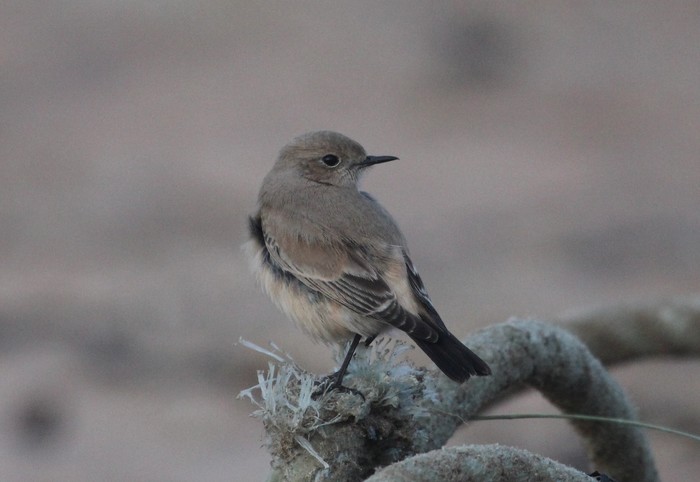
One species that has never before registered January as a date of occurrence in the UK is Subalpine Warbler but the first-winter female in the gardens of St. Just (Cornwall) has blown all records away now. Present all week, the bird has been on site for almost two months already (appearing on November 17th, one of the latest-ever arrivals for the species ~ as already mentioned in the RBA review that covered the week concerned, there have been nine other November arrivals, the Cornish bird being the latest-ever to be found.
A little more typical of occasional winter appearances are the following five species and we’ll start with the reappearance of the Dusky Warbler in Lower Moors, St. Mary’s (Scilly) on 8th, having last been noted on December 15th. In Devon, the first-winter Rose-coloured Starling found at Exminster in the second week of December was present all week along Millbury Lane. Two Yellow-browed Warblers were found ~ a singing male was at Moor Green Lakes (Hampshire/Berkshire border) from 3rd and one was at Dinas Cross (Pembrokeshire) on 5th. On St. Mary’s (Scilly) a Richard’s Pipit was discovered along the road to Telegraph on 6th while in Norfolk, the (occasionally) remarkably elusive Black-bellied Dipper was back again on the River Thet in Thetford from 3rd (having last been seen there for sure on December 6th).
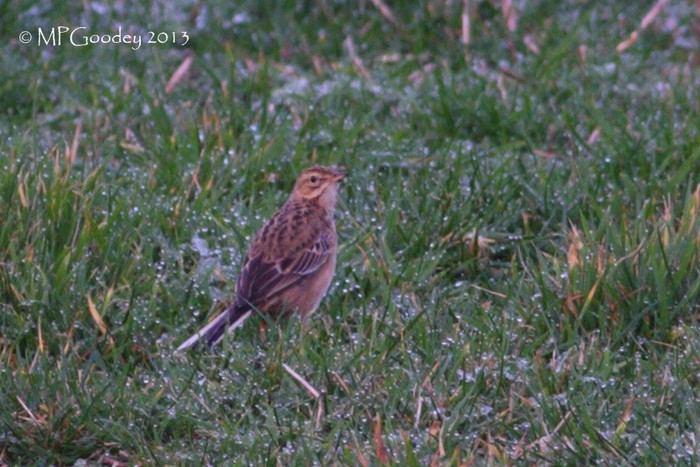
Great Grey Shrikes nudged double figures ~ just ~ this week, with 11 birds recorded, almost all “regular” wintering birds from recent weeks. New was one at Streatley (Bedfordshire) on 5th and one became two near Warminster (Wiltshire) on 2nd. In the New Forest, two singles were seen during the week, at Bishop’s Dyke and Denny Lodge and others remained in Aberdeenshire, Denbighshire, Staffordshire, Derbyshire, Hertfordshire and Surrey.
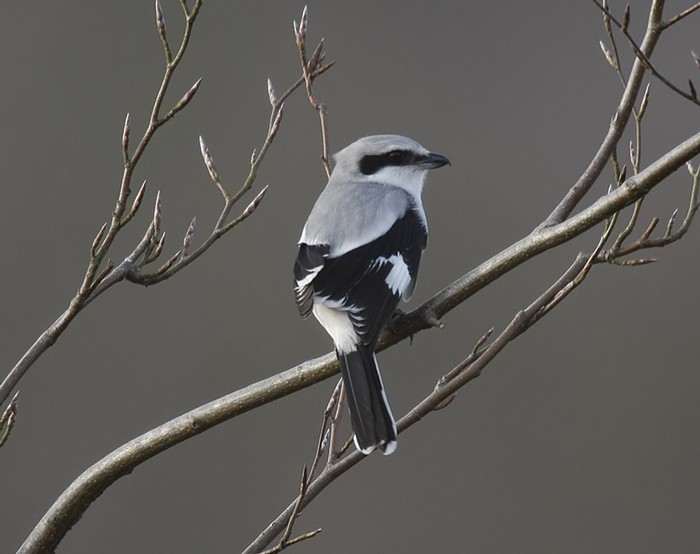
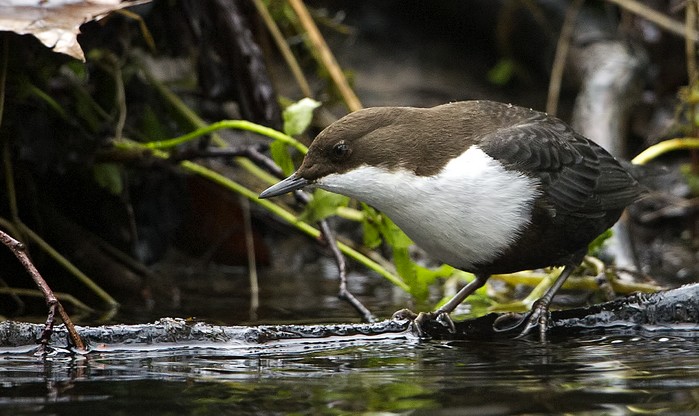
The number of Waxwings recorded countrywide remained relatively high but nowhere near the numbers seen during late November and early December. Birds were spread from the north of Scotland to the far southwest of England, with most concentrated through the spine of England, through the South Yorkshire, Nottingham and down in to counties such as Northamptonshire, with plenty of overspill on either side, and on in to the southeast.
At least 16 three figure flocks were reported this week ~ the largest being 200 in Keighley (West Yorkshire) on 3rd with 175 birds in Huddersfield (also in West Yorkshire) the previous day. Up to 150 Waxwings were seen in Sale, Greater Manchester on 7th and in Liverpool, near Penny Lane, 135 birds were counted on 3rd with 150 at Seaforth on 5th.
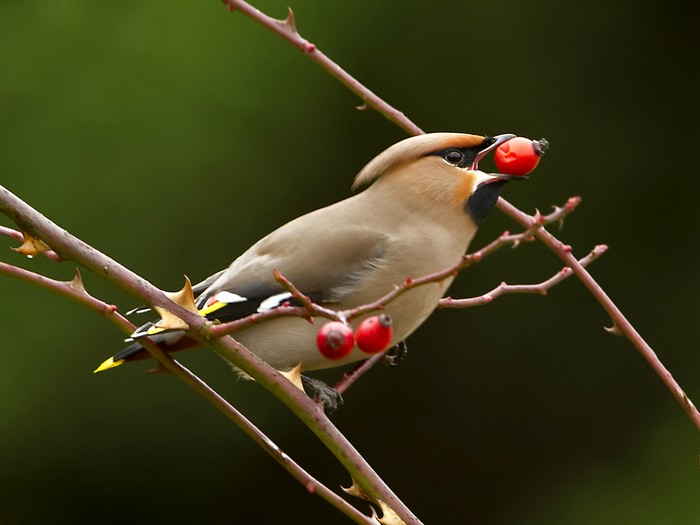
Two groups of 100 or so flew over Pegwell Bay (Kent) on 3rd and 4th, and around 140 were in Milton Keynes (Buckinghamshire) on 7th.
In Ireland, there were still a couple of decent gatherings ~ 120 were in Dublin on 2nd and 160 were at Hazelhatch, in County Kildare, on 3rd.
The first full review of 2013 ends with news of a brief sighting of a Penduline Tit in the reedbed off the Lampen Wall, at Stodmarsh (Kent) on 5th. This was the sight of the county’s very first Penduline Tit, a male, in May 1980 and was followed by the fourth in November 1983, a bird which was then thought to have reappeared the following March, when it was well-twitched by many (ticks were always worth bunking off school for….).
Only a handful have followed (less than five) in the following 30 odd years ~ Dungeness, as we’ve touched on before here, now reigns supreme in the Garden of England with well over 30 accepted records of the species (including several multiples).
So there we go then ~ we’re up and running in 2013. There’s so many things that so many people have on their wishlist for the following 12 months. Many at the top are birds that have been top of the “most wanted” list for years ~ you can reel them off straight away…..
…..there’s Wallcreeper of course (many people’s #1) ~ nearly 28 years since the last one fluttered around St. Catherine’s Point on the Isle of Wight. The notion that we may, one day get another Houbara (or, more accurately, Macqueen’s Bustard) remains as fanciful now as it did in any number of previous recent New Year thoughts (we’ve just skipped past the Golden Anniversary of that one).
And talking of anniversaries ~ we’re now just two months away from the Pearl Anniversary of one of the most infamous birds of the last 30 years…..the Spurn Tengmalm’s Owl.
Present for 22 days, 22 days when the fragile land mass was arguably at its weakest after a mass of gales and storms, the eventual release of the news caused allsorts of hoo-hah. Not your metaphorical online “gloves off at 20 paces” dustup that is so commonplace when egos clash in the world of birding forums, oh no, this was the real deal.
Arguments and bad feeling raged for months and months, years even, afterwards….many embittered active twitching souls from the time are still waiting for the chance to lay that particular suppressed demon to bed, once and for all…..
Will 2013 be the year for any of the trio of most wanteds? Or, as seems more likely, the birds that may cause the most consternation this year may be birds so crazy that you could never, ever predict them….
Last year’s cream of the crop, Western Orphean Warbler, Magnolia Warblerand even Eastern Kingbird were always on the cards and, sure enough, they came.
But when vagrants become as off the scale as Portland’s ”pale-legged” Leaf Warbler come riding in to town, we know that betting really is a mug’s game.
All bets are off then as we play the waiting game once more…..
Mark Golley
09 January 2013
(PS ~ Ringwood and Marloes Mere for your extra Ibis....!)

Wallcreeper ~ the most recent record came in May 1985 on the Isle of Wight, the most recent twitchable one of these was, of course, the famous Cheddar gorge bird in the winters of 1976-'77 and 1977-'78....despite birds making it to the near-continent, many birders are still waiting for another one to cross the English Channel.
Tengmalm's Owl ~ hand's up, who's seen this one in the UK? The last accepted British record occurred on Orkney in 1986, but its the infamous Spurn bird of 1983 that most folk remember. There have been just seven records since the end of the 1950's, but 52 accepted records in all. Is there another bird on the British List with so many records that has been seen by so few living observers? No.
Houbara ~ with just five records and the most recent coming over 50 years ago, the odds on another Houbara (or Macqueen's) Bustard seem more remote than ever. But Belgium scored one, out of the blue, in January 2003, so there is a glimmer of hope.....





